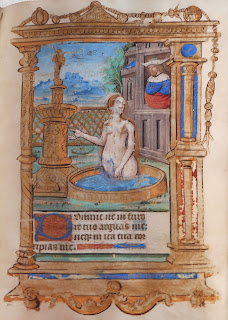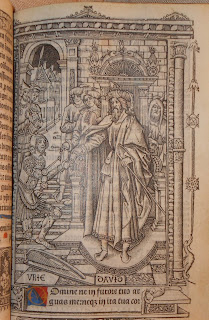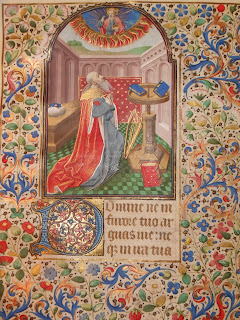 A powerful man, a king in this case, lustfully looks down on a woman in her bath--a woman whom he will sexually molest. A powerful man, again a king, handing a letter to a man who will not be complicit in his sin--a letter that instructs the man's commanding officer to abandon him in the heat of battle and guarantee his death. A powerful man, penitent for his sins, composing psalms in praise of the lord, passages that are among the most beautiful in the Bible. This is, of course, the story of David and Bathsheba. What is fascinating here is the three very different ways David and his victims are depicted in these three 15th-century Books of Hours. But what is so troubling is how utterly poignant and timely all three are.
A powerful man, a king in this case, lustfully looks down on a woman in her bath--a woman whom he will sexually molest. A powerful man, again a king, handing a letter to a man who will not be complicit in his sin--a letter that instructs the man's commanding officer to abandon him in the heat of battle and guarantee his death. A powerful man, penitent for his sins, composing psalms in praise of the lord, passages that are among the most beautiful in the Bible. This is, of course, the story of David and Bathsheba. What is fascinating here is the three very different ways David and his victims are depicted in these three 15th-century Books of Hours. But what is so troubling is how utterly poignant and timely all three are. David was the hero of his nation and adored by his subjects. This is Michaelanglo's paragon of masculinity, larger than life, slayer of giants, father of Solomon, founder of the House of David and progenitor of Jesus. Yet, as so many have done through history, he took advantage of his power to abuse a woman, then killed a man to cover it up before being confronted by the prophet Nathan. He probably would have gotten away with it if that single courageous soul hadn't stood up to him.
David was the hero of his nation and adored by his subjects. This is Michaelanglo's paragon of masculinity, larger than life, slayer of giants, father of Solomon, founder of the House of David and progenitor of Jesus. Yet, as so many have done through history, he took advantage of his power to abuse a woman, then killed a man to cover it up before being confronted by the prophet Nathan. He probably would have gotten away with it if that single courageous soul hadn't stood up to him. These images constitute a base for constructing a usable past. They give us the opportunity to look back and find moments that we can learn from and build upon for productive use today. If we can trace an historical narrative, we can help to justify and argue for the social changes we want to affect. We can use the past to create the future we desire. This is the active, forward thinking form of the dire warning, “whoever forgets the past is doomed to repeat it.” Instead, we argue that "whoever looks to the past can create the future he or she wants." In this case, don't be complicit, instead take action and change the culture.
These images constitute a base for constructing a usable past. They give us the opportunity to look back and find moments that we can learn from and build upon for productive use today. If we can trace an historical narrative, we can help to justify and argue for the social changes we want to affect. We can use the past to create the future we desire. This is the active, forward thinking form of the dire warning, “whoever forgets the past is doomed to repeat it.” Instead, we argue that "whoever looks to the past can create the future he or she wants." In this case, don't be complicit, instead take action and change the culture.To see it all for yourself, ask for Codex MS 001598 (lustful David); Incunabula 154 (vengeful David); and Codex MS 003141 (penitent David).
No comments :
Post a Comment